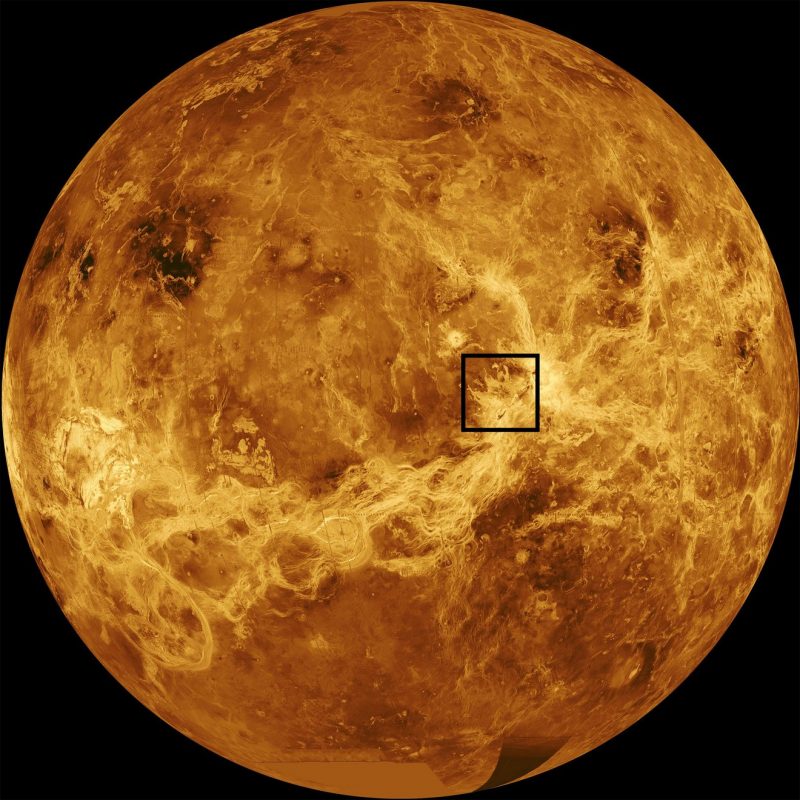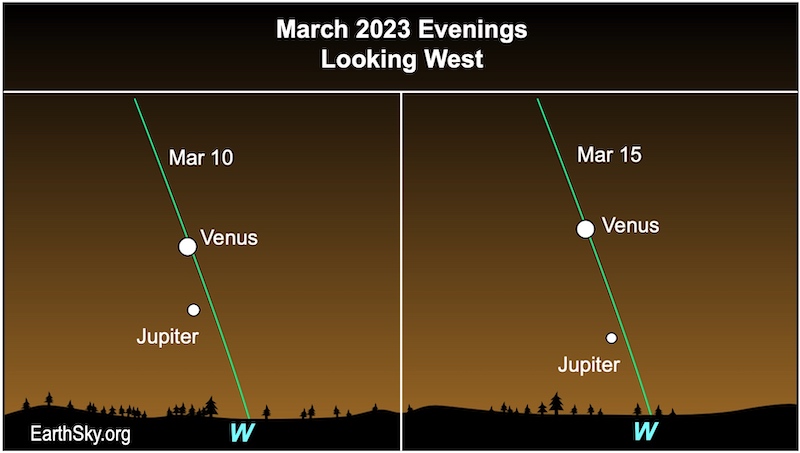
Magellan data reveal active volcanoes on Venus
Venus has long been considered a “twin” to Earth. It’s nearly the same size as Earth, and the same density. And it’s only one step closer to the sun than Earth. But Venus has a strong greenhouse effect going on in its atmosphere. So its surface is hot enough to melt lead, and it’s completely enshrouded in clouds. One big mystery about Venus has been the volcano-like mountains on its surface, seen via cloud-penetrating radar. They look like volcanoes. But are they active volcanoes? On March 15, 2023, in a first, scientists announced they now have in hand the direct evidence of active volcanoes on Venus.
A statement from NASA’s Jet Propulsion Laboratory in Pasadena California explained:
Scientists made the discovery after poring over archival radar images of Venus taken more than 30 years ago, in the 1990s, by NASA’s Magellan mission. The images revealed a volcanic vent [on a known volcano-like mountain called Maat Mons] changing shape and increasing significantly in size in less than a year.
The archival search and its conclusions are described in a new study published in the journal Science.
The scientists liken the size of the lava flow generated by the Maat Mons activity to the 2018 Kilauea eruption on the Big Island of Hawaii.
Last chance to get a moon phase calendar! Only a few left. On sale now.
A successful search of Magellan’s archives
Robert Herrick – a research professor at the University of Alaska Fairbanks – led the search of Magellan’s archival data. He presented the new findings at the 54th Lunar and Planetary Science Conference in the Woodlands, Texas, on March 15, 2023.
Herrick is also a member of a team that’s planning a space mission to Venus. The mission is called VERITAS – short for Venus Emissivity, Radio science, InSAR, Topography, And Spectroscopy. And it’s planned to launch within a decade.
Herrick commented on what prompted him to look closer at data from the earlier Magellan mission:
NASA’s selection of the VERITAS mission inspired me to look for recent volcanic activity in Magellan data. I didn’t really expect to be successful, but after about 200 hours of manually comparing the images of different Magellan orbits, I saw two images of the same region taken eight months apart exhibiting telltale geological changes caused by an eruption.
And JPL explained:
The VERITAS orbiter will study Venus from surface to core to understand how a rocky planet about the same size as Earth took a very different path, developing into a world covered in volcanic plains and deformed terrain hidden beneath a thick, hot, toxic atmosphere.

Modeling active volcanoes on Venus
The geological changes Herrick found occurred in Atla Regio, a vast highland region near Venus’ equator that hosts two of the planet’s largest volcanoes, Ozza Mons and Maat Mons. The region has long been thought to be volcanically active. But there was no direct evidence of recent activity.
While scrutinizing Magellan radar images, Herrick identified a volcanic vent associated with Maat Mons that changed significantly between February and October 1991.
In the February image, the vent appeared nearly circular, covering an area of less than 1 square mile (2.2 square kilometers). It had steep interior sides and showed signs of drained lava down its exterior slopes, factors that hinted at activity. In radar images captured eight months later, the same vent had doubled in size and become misshapen. It also appeared to be filled to the rim with a lava lake.
But because the two observations were from opposite viewing angles, they had different perspectives, which made them difficult to compare. The low resolution of the three-decade-old data only made the work more complicated.
#Venus appears to have volcanic activity. A new research paper offers strong evidence that planet currently has eruptions & lava flows. The new research focused on an area containing two of Venus' largest volcanoes, Ozza & Maat Mons.
?? https://t.co/bB5O8ReyIL pic.twitter.com/WBLTphy9ZC
— Girl In Space ? (@ExploreCosmos_) March 15, 2023
How they figure it out
Herrick teamed up with JPL’s Scott Hensley, the project scientist for VERITAS and a specialist in analyzing radar data like Magellan’s. The two researchers created computer models of the vent in various configurations to test different geological-event scenarios, such as landslides.
From those models, they concluded that only an eruption could have caused the change. Hensley explained:
Only a couple of the simulations matched the imagery, and the most likely scenario is that volcanic activity occurred on Venus’ surface during Magellan’s mission.
While this is just one data point for an entire planet, it confirms there is modern geological activity.
Look for Venus after sunset

Bottom line: Scientists have evidence for an active volcanic vent on a known Venus mountain. It’s the first direct evidence of active volcanoes on Venus!
The post Active volcanoes on Venus found in Magellan data first appeared on EarthSky.
from EarthSky https://ift.tt/kryHblT

Magellan data reveal active volcanoes on Venus
Venus has long been considered a “twin” to Earth. It’s nearly the same size as Earth, and the same density. And it’s only one step closer to the sun than Earth. But Venus has a strong greenhouse effect going on in its atmosphere. So its surface is hot enough to melt lead, and it’s completely enshrouded in clouds. One big mystery about Venus has been the volcano-like mountains on its surface, seen via cloud-penetrating radar. They look like volcanoes. But are they active volcanoes? On March 15, 2023, in a first, scientists announced they now have in hand the direct evidence of active volcanoes on Venus.
A statement from NASA’s Jet Propulsion Laboratory in Pasadena California explained:
Scientists made the discovery after poring over archival radar images of Venus taken more than 30 years ago, in the 1990s, by NASA’s Magellan mission. The images revealed a volcanic vent [on a known volcano-like mountain called Maat Mons] changing shape and increasing significantly in size in less than a year.
The archival search and its conclusions are described in a new study published in the journal Science.
The scientists liken the size of the lava flow generated by the Maat Mons activity to the 2018 Kilauea eruption on the Big Island of Hawaii.
Last chance to get a moon phase calendar! Only a few left. On sale now.
A successful search of Magellan’s archives
Robert Herrick – a research professor at the University of Alaska Fairbanks – led the search of Magellan’s archival data. He presented the new findings at the 54th Lunar and Planetary Science Conference in the Woodlands, Texas, on March 15, 2023.
Herrick is also a member of a team that’s planning a space mission to Venus. The mission is called VERITAS – short for Venus Emissivity, Radio science, InSAR, Topography, And Spectroscopy. And it’s planned to launch within a decade.
Herrick commented on what prompted him to look closer at data from the earlier Magellan mission:
NASA’s selection of the VERITAS mission inspired me to look for recent volcanic activity in Magellan data. I didn’t really expect to be successful, but after about 200 hours of manually comparing the images of different Magellan orbits, I saw two images of the same region taken eight months apart exhibiting telltale geological changes caused by an eruption.
And JPL explained:
The VERITAS orbiter will study Venus from surface to core to understand how a rocky planet about the same size as Earth took a very different path, developing into a world covered in volcanic plains and deformed terrain hidden beneath a thick, hot, toxic atmosphere.

Modeling active volcanoes on Venus
The geological changes Herrick found occurred in Atla Regio, a vast highland region near Venus’ equator that hosts two of the planet’s largest volcanoes, Ozza Mons and Maat Mons. The region has long been thought to be volcanically active. But there was no direct evidence of recent activity.
While scrutinizing Magellan radar images, Herrick identified a volcanic vent associated with Maat Mons that changed significantly between February and October 1991.
In the February image, the vent appeared nearly circular, covering an area of less than 1 square mile (2.2 square kilometers). It had steep interior sides and showed signs of drained lava down its exterior slopes, factors that hinted at activity. In radar images captured eight months later, the same vent had doubled in size and become misshapen. It also appeared to be filled to the rim with a lava lake.
But because the two observations were from opposite viewing angles, they had different perspectives, which made them difficult to compare. The low resolution of the three-decade-old data only made the work more complicated.
#Venus appears to have volcanic activity. A new research paper offers strong evidence that planet currently has eruptions & lava flows. The new research focused on an area containing two of Venus' largest volcanoes, Ozza & Maat Mons.
?? https://t.co/bB5O8ReyIL pic.twitter.com/WBLTphy9ZC
— Girl In Space ? (@ExploreCosmos_) March 15, 2023
How they figure it out
Herrick teamed up with JPL’s Scott Hensley, the project scientist for VERITAS and a specialist in analyzing radar data like Magellan’s. The two researchers created computer models of the vent in various configurations to test different geological-event scenarios, such as landslides.
From those models, they concluded that only an eruption could have caused the change. Hensley explained:
Only a couple of the simulations matched the imagery, and the most likely scenario is that volcanic activity occurred on Venus’ surface during Magellan’s mission.
While this is just one data point for an entire planet, it confirms there is modern geological activity.
Look for Venus after sunset

Bottom line: Scientists have evidence for an active volcanic vent on a known Venus mountain. It’s the first direct evidence of active volcanoes on Venus!
The post Active volcanoes on Venus found in Magellan data first appeared on EarthSky.
from EarthSky https://ift.tt/kryHblT

Aucun commentaire:
Enregistrer un commentaire